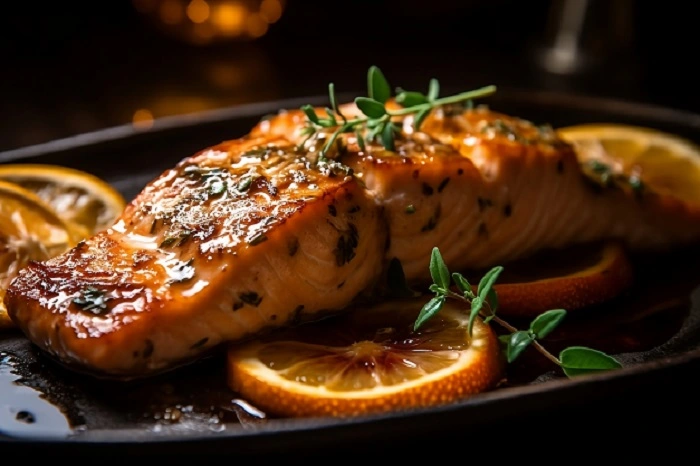1. Salmon
The Superfood Secret to a Healthier You!
2. Sardines
The Tiny Titans of Health You Need to Try Today!
3. Kale
The Leafy Green Superhero That'll Transform Your Plate!
4. Seaweed
The Ocean's Best-Kept Health Secret You Must Taste!
5. Garlic
The Flavorful Miracle Worker for Your Health and Taste Buds!
Knowing which are the top 5 nutrition-dense foods might help you plan your meals and eat healthier. However, keep in mind that one item cannot provide your body with all of the nutrients it requires; a diverse diet is ideal.
Nutrient-dense foods include extremely little sugar, carbohydrates, salt, and fats that are toxic. Despite their high vitamin and mineral content, they are quite low in calories. Micronutrients, such as vitamins and minerals, are extremely crucial to your health. They provide the nutrients your body requires to stay healthy. By using them, you can reduce your risk of developing long-term diseases. Taking them with food allows the body to absorb them better. You should consume plenty of nutritious meals.
Eating a variety of foods allows you to obtain more of the vitamins and minerals your body requires. Fruits and vegetables are naturally high in nutrients, and foods with high levels of nutrients are referred to as "nutrient dense." Let’s explore the top 5 nutrient dense food with CrazyTop5!
Why Are Nutrient-Dense Foods Important?
Healthy meals contain fruits, vegetables, whole grains, nuts, seeds, fatty acids, amino acids (protein building blocks), and other essential nutrients. A nutrient-dense diet can also be referred to as anti-inflammatory. This is critical for avoiding chronic diseases and the risk factors associated with them, such as diabetes, heart disease, obesity, and high blood pressure.
Here's a list of high-nutrient items.
1. Salmon
The Superfood Secret to a Healthier You!
 Salmon is a nutritious food because it contains protein, omega-3 fatty acids, and a variety of vitamins and minerals. It is often suggested as part of a healthy diet.
Salmon is a nutritious food because it contains protein, omega-3 fatty acids, and a variety of vitamins and minerals. It is often suggested as part of a healthy diet.
Mercury is found in every fish, but salmon contains significantly less of it than other species. This makes salmon an excellent alternative for those who want to be exposed to less mercury. Salmon also contains a lot of selenium, which helps protect against mercury poisoning.
Omega-3 fatty acids benefit the brain and reduce the chances of heart disease. They also relieve arthritic pain and reduce inflammation. Salmon is an excellent source of omega-3 fatty acids and one of the finest places to learn about them.
Top 5 benefits of Salmon are:
- Rich in Omega-3 Fatty Acids: EPA and DHA are two of the most beneficial omega-3 fatty acids you can consume daily. Salmon is rich in these acids. These vital lipids are required for proper brain function, reduced inflammation, and healthy hearts.
- High-Quality Protein: Such as that found in salmon, is essential for muscle development, healing, and overall good health. Food provides all of the amino acids required for the body to function optimally.
- Avoids Heart Disease: Eating salmon regularlyreduces your risk of developing heart disease. Salmon contains omega-3 fatty acids, which can help decrease blood pressure and cholesterol and improve heart function.
- Rich in Nutrients: Salmon is a nutrient-dense food because it contains several minerals and vitamins, including potassium, selenium, vitamin D, and vitamin B12. These nutrients are necessary for many bodily activities, including bone health, metabolism, and immune system function.
- Good for Brain Health: Omega-3 fatty acids, which are rich in salmon, promote brain growth and development. They may reduce the effects of neurodegenerative disorders such as Alzheimer's and cognitive decline associated with ageing and improve mood, memory, and brain function.
2. Sardines
The Tiny Titans of Health You Need to Try Today!
 Because our bodies cannot produce these essential fatty acids, we must obtain them from diet, and sardines are one of the greatest options.
Because our bodies cannot produce these essential fatty acids, we must obtain them from diet, and sardines are one of the greatest options.
Studies have demonstrated that omega-3 fatty acids aid people with inflammatory disorders such as rheumatoid arthritis, type 1 diabetes, asthma, allergies, and many others and reduce their risk of developing these diseases. It is widely acknowledged that omega-3 fatty acids help reduce inflammation.
Top 5 benefits of Sardines are:
- Excellent Source of Omega-3 Fatty Acids: Sardines are an excellent source of omega-3 fatty acids, especially EPA and DHA. These fats help keep your heart healthy, reduce inflammation, and keep your brain functioning correctly.
- High in Protein: They contain all nine amino acids that the body requires to grow and repair muscles and keep them functioning correctly. Substantial in protein, sardines are an excellent addition to a balanced diet since they keep you satisfied.
- Rich in Essential Nutrients: Sardines include a variety of essential elements, including vitamin B12, selenium, calcium, and phosphorus. These nutrients support the immune system, aid in energy metabolism, and promote healthy skin and hair.
- Sustainable and Environmentally Friendly: Sardines are less likely to be overfished because they reproduce rapidly and are abundant in the waters. By choosing sardines, you are supporting environmentally friendly fishing methods and helping to safeguard marine ecosystems.
- Promotes Heart Health: Sardines contain omega-3 fatty acids, which promote heart health by decreasing inflammation and cholesterol. Eating them regularly may reduce your risk of heart disease.
3. Kale
The Leafy Green Superhero That'll Transform Your Plate!
 Like spinach and other leafy greens, kale contains high levels of antioxidants, fibre, vitamin C, and omega-3 and -6 fatty acids. It is also the most nutritionally complete food on the menu. KALE has many nutrients that will improve the appearance and feel of your skin, nails, and hair. It also benefits the immune system and reduces swelling.
Like spinach and other leafy greens, kale contains high levels of antioxidants, fibre, vitamin C, and omega-3 and -6 fatty acids. It is also the most nutritionally complete food on the menu. KALE has many nutrients that will improve the appearance and feel of your skin, nails, and hair. It also benefits the immune system and reduces swelling.
Kale is relatively easy to grow. When the plants reach a height of about 4 inches (10 cm), move them outside and plant the seeds early in the year. Strap-leafed dark Tuscan kale is our preferred pick because it is both delicious and nutritious.
Top 5 benefits of Kale are:
- Nutrient Powerhouse: Kale contains several minerals, including folate, calcium, potassium, manganese, and vitamins A, C, and K. One cup of kale contains more vitamins A and K than is required daily.
- Antioxidant-Rich: Kale is high in antioxidants, including carotenoids, flavonoids, other carotenoids, and quercetin. These molecules protect cells against reactive stress and may aid in the treatment of cancer and cardiovascular disease.
- Heart Health: Kale contains many heart-healthy elements, including fibre, potassium, and vitamins. Fibre and potassium help to keep blood pressure and cholesterol levels within acceptable limits. Inflammation is a significant contributor to heart disease, and the vitamins in kale help to reduce this risk.
- Bone Health: Kale has a lot of vitamin K, which helps the body absorb calcium and keeps bones strong. Adequate consumption of vitamin K has been related to a lower incidence of osteoporosis and fracture.
- Weight Management: Kale is an excellent weight-loss food because it is low in calories and high in protein. The high fibre content keeps you full and satisfied for longer, allowing you to eat fewer calories. Kale contains vitamins and minerals that are highly beneficial to your health and do not add any additional calories.
4. Seaweed
The Ocean's Best-Kept Health Secret You Must Taste!
 The term "seaweed" refers to a vast collection of plants that grow underwater, such as those found in the ocean and other bodies of water. "Seaweed" covers a wide range of marine plants, including kelp, nori, wakame, and dulse.
The term "seaweed" refers to a vast collection of plants that grow underwater, such as those found in the ocean and other bodies of water. "Seaweed" covers a wide range of marine plants, including kelp, nori, wakame, and dulse.
Seaweed contains antioxidants, vitamins A, C, and E, which help keep you healthy. It also contains the trace chemical iodine, which is required for the thyroid to function correctly.
When trying a new meal, such as seaweed, you should take it carefully. People who are allergic or sensitive to foods should exercise special caution.
Top 5 benefits of Seaweed are:
- Rich in Essential Nutrients: Seaweed contains a variety of essential minerals, including vitamins A, C, and K, as well as iodine, calcium, magnesium, and iron. Your body requires specific nutrients to function correctly.
- Source of Iodine:Seaweed is an excellent source of iodine, which is necessary for hormone production and thyroid health. Adequate iodine consumption is also essential for maintaining metabolism and energy levels.
- High in antioxidants: Seaweed contains crucial amounts of antioxidants such as vitamins C and E, carotenoids, and flavonoids. These antioxidants protect the body from potentially fatal diseases such as cancer and heart disease by lowering reactive stress and inflammation levels.
- Support Gut Health:Seaweed is healthy for your digestive health because it contains soluble fibre, which promotes regular bowel movements and prevents constipation. Seaweed's prebiotic fibre feeds beneficial bacteria in the digestive tract, hence maintaining a healthy microbiome.
- May Aid Weight Loss: Seaweed is a healthy and fun weight-reduction diet because it is low in fat and calories but high in fibre. Fibre makes you feel full on fewer calories, so it may help you limit calories and lose weight faster. According to certain studies, seaweed may also help boost your metabolism and burn more fat.
5. Garlic
The Flavorful Miracle Worker for Your Health and Taste Buds!
 Garlic is a key component in many recipes. The good news is that it's quite healthy for our health! Garlic is an excellent approach to improving your immune system because it contains many minerals (such as manganese, calcium, and tryptophan) and vitamins (particularly B1). It not only benefits our livers but also promotes the health of our lungs and intestines. It is much healthier if you let chopped or crushed garlic sit for 20 minutes before eating it.
Garlic is a key component in many recipes. The good news is that it's quite healthy for our health! Garlic is an excellent approach to improving your immune system because it contains many minerals (such as manganese, calcium, and tryptophan) and vitamins (particularly B1). It not only benefits our livers but also promotes the health of our lungs and intestines. It is much healthier if you let chopped or crushed garlic sit for 20 minutes before eating it.
Garlic grows best in well-drained soil. Plant it in the autumnand harvest it in early summer.
Top 5 benefits of Garlic are:
- Immune System Boost: Garlic can fight infections because it contains allicin and other compounds that boost the immune system. Consuming garlic daily may reduce the severity and duration of cold and flu symptoms.
- Better Heart Health: Garlic may help lower blood pressure and cholesterol, both risk factors for heart disease. It may also reduce the risk of heart disease by improving circulation and inhibiting arterial plaque formation.
- Antioxidant Properties: Antioxidants protect cells from free radical damage and are one of garlic's many benefits. Some research suggests that these antioxidants may help reduce the ageing process and prevent the emergence of cancer and other long-term disorders.
- Anti-Inflammatory Effects: These qualities reduce systemic inflammation and the symptoms of inflammatory illnesses such as arthritis. Consuming garlic daily may reduce the likelihood of chronic inflammation and associated repercussions.
- Antibacterial and Antiviral: Garlic is effective against many pathogens due to its natural capacity to kill bacteria and viruses. This could make it easier to treat or prevent illnesses, including those caused by antibiotic-resistant microorganisms.
How to Include Nutrient-Dense Foods in Your Diet?
Most people define a healthy eating nutrient dense meal plan as consuming more nutrient-dense vegetables and gradually adding other types of vegetables to their diet.
There are many different types of mixed dishes that contain vegetables. Vegetables commonly appear in pizza, stews, spaghetti, soups, and grain-based casseroles. There are two methods to eat more vegetables while maintaining the nutritional content of these foods: add more vegetables to mixed meals or eat fewer main dishes with more vegetables as sides.
If you want to sneak vegetables into your children's favourite foods, add sliced zucchini or carrots to meatloaf, chilli, stew, or spaghetti sauce.
To enhance the flavour of your vegetables, add chopped nuts, balsamic vinegar, olive oil, or gourmet oil such as sesame or walnut oil. Most grocery stores provide a variety of spice mixtures designed to go with veggies.
Keep in mind that where you live significantly impacts what you eat and your overall health. Fruits and readily available vegetables encourage you to consume more of them. When less healthy items are around, they are easier to reach for.
FAQs
Q. Which food is the most nutrient-dense?
No single food can provide all of the nutrients your body needs, but potatoes are one of the most important because they are readily available and high in nutrients. People in many parts of the world rely on this source for non-cereal staple crops required for food security.
Q. What is the number 1 healthiest food in the world?
There is no such thing as the healthiest food, but the optimum diet will have a variety of nutrients derived from fresh plant-based meals.
Q. What are the six essential nutrients?
The body requires six types of foods: water, vitamins, minerals, fats, proteins, and carbohydrates.
Q. What are some of the most nutritious foods?
Eggs, avocados, potatoes, fatty salmon, and green leafy vegetables are among the healthiest foods.
Because our bodies cannot get all the nutrients they require from a single source, it is critical to eat a variety of fresh foods and limit our intake of processed food.
Q. What happens after consuming nutrient-dense food?
Eating foods abundant in nutrients keeps your body healthy and nourished.
Q. What do nutrient-dense foods have?
Nutrient-dense foods contain low levels of harmful fats, sugar, salt, and carbs. Despite their high vitamin and mineral content, theyhave lowcalories.
Q. What are the two types of nutrients?
These nutrients can be processed to produce macronutrients and vitamins.
Final Thought
A healthy diet involves more than just counting calories. Consuming various foods from each food category in small quantities is also crucial.
Nutrient-dense foods include a high variety of vital vitamins, minerals, and nutrients relative to their most calorie dense food. This category of healthful foods contains vegetables, fruits, chocolate, seafood, eggs, and meat.
Most dietary guidelines state that consuming various nutrient-dense meals is optimal for health. This allows you to maintain a stable weight and avoid chronic diseases such as type 2 diabetes, heart disease, and others connected to poor food choices.






